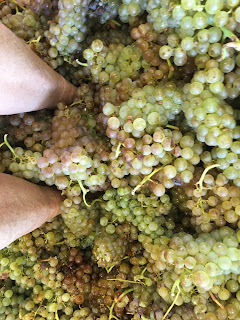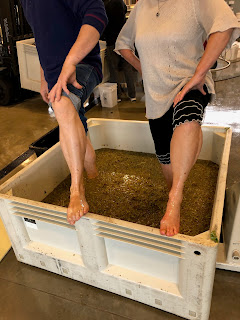As soon as I stepped into the bin of grapes in the big winemaking warehouse of T2 Cellar in Seattle, I felt like one of the peasants depicted in Medieval illuminated manuscripts: stomping the grapes in large barrels, dancing a jig to the lively tune of fiddles while brawny lads haul more bins of grapes from the vineyard and everyone—men, women, youths, and children—enjoys a festive harvest on a sunny autumn day.
It wasn't quite like that, especially because in those days the men did the stomping because women, of course, wouldn't be lifting their skirts and showing their legs. Also, although it was a sunny autumn day in Seattle, we were indoors, in a very clean warehouse where T2 Cellar makes its wine. There wasn't a speck of dirt anywhere, and my son, Ela, and I cleaned and sanitized our feet in four sequenced buckets before stepping onto the grapes.
(I wondered what kind of sanitization the peasants did to their feet.) Everything else was pretty much as it was centuries ago. We were stomping on the grapes because the grapes needed to be pulverized, and, as in days of yore, there was no better way to do it than with the feet.
This being the era of machines, however, and hand (or in this case foot) labor being more costly for the winemaker than machines (unless the winemaker has willing friends to come and help for the fun of it), winemakers now use a machine, called a destemmer,
 |
| Todd Threlkeld, with Grenache grapes, destemmer in the background |
which does the work of foot-stomping for the Granache and Sangiovese grapes T2 Cellar uses for red wine. The destemmer will juice the grapes and send them through tubes into storage jars in one smooth process. The foot-stomping was for the Marsanne grapes, a white-wine variety, which weren't numerous enough for T2 Cellar's large press and unsuitable for the small basket press, which doesn't press white clusters very well. Therefore, Todd Threlkeld, head winemaker, told me, "the stomping was not a lark but the most efficient and effective way to process a small amount of grapes"—fortunately for me, because it was a lot more fun to squish grapes with my feet than to pour grapes into a machine.
Just as in Medieval days, there was music, if not fiddlers on the ground, then contemporary rock music on the stereo, that had us jumping and dancing like the peasants, at least for a while.
Pretty soon I began thinking this was a lot of work, after all, until an experienced wine-maker told me it wasn't necessary to jump. We just had to squeeze the grapes until no more balls of grapes rolled under our feet. After that I stepped firmly but quietly onto the grapes, pressing hard, taking small steps, chasing with the next step the grapes that escaped towards the edges of the bin.
When all the grapes had been brought to submission, when there were no more rolling balls of grapes underfoot,
we poured the resulting pulp into a press, another ancient piece of equipment, and turned the crank to press pulp into juice, which we then poured into large jars.
Now I was catapulted not into the Middle Ages but to my father's basement, where I used to help him bottle his wine when I came to visit from Oregon. He would have enjoyed this day with me.
After pulping, pressing, and pouring, the six of us working on winemaking that day had delicious dolmas and falafels from a near-by Greek deli, washed down with some tastes of T2 Cellar wine. Good wine. The next time I go to Seattle, I want to go to T2 Cellar and have some white wine from Marsanne grapes. I'll lift my glass to the light and squint, seeing in the wine my bare feet stomping the grapes in the bin like a peasant at harvest in a vineyard.






No comments:
Post a Comment